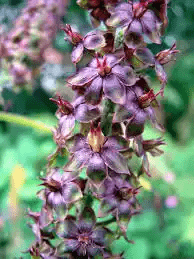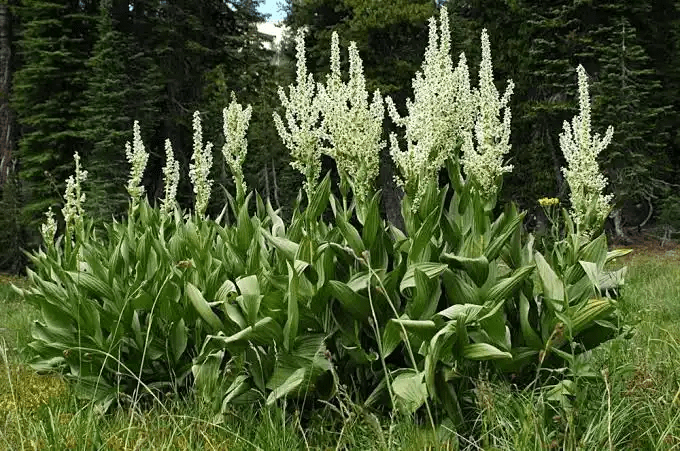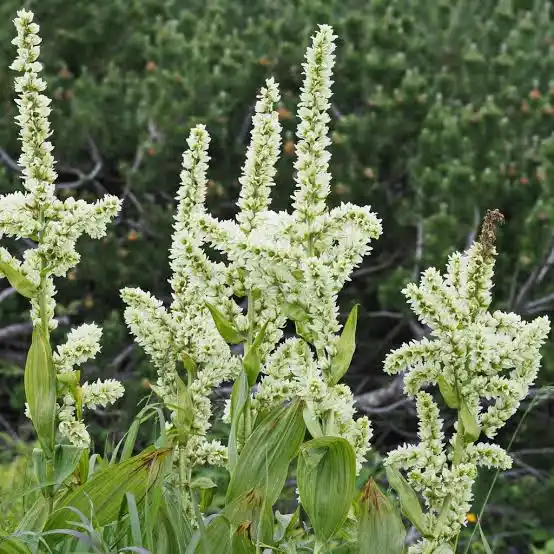Veratrum, a genus encompassing perennial flowering plants, holds a mysterious allure within the botanical realm.
Often known by various names such as false hellebore or corn lily, Veratrum species are renowned for their striking appearance and historical significance, intertwined with both traditional medicine and cautionary tales.
These robust plants typically flourish in temperate regions across the Northern Hemisphere, preferring damp, shaded areas within woodlands or mountainous landscapes.
Their towering stature and impressive leafy crowns create a commanding presence in their natural habitats. Veratrum’s long, lance-shaped leaves spiral gracefully around sturdy stems, presenting a lush, verdant display that captures the eye.
One of the defining characteristics of Veratrum lies within its inflorescence. Towering stalks adorned with numerous small, greenish-white flowers form elaborate clusters, contributing to the grandeur of these plants.
The intricate symmetry and unassuming beauty of the blooms belie the potent toxicity that resides within them, serving as a cautionary signal to both humans and animals.
Veratrum’s toxicity, primarily attributed to alkaloids present in various parts of the plant, is a double-edged trait. While it poses a significant risk when ingested, it also bestows potential medicinal properties.
Throughout history, certain Veratrum species have been utilized in traditional medicine despite their inherent dangers. Extracts from these plants were historically employed to address ailments ranging from fevers to high blood pressure, albeit with extreme caution due to their toxicity.
Beyond their medicinal applications, Veratrum’s toxicity acts as a natural defense mechanism, warding off herbivores and deterring potential threats in the ecosystem.
This intriguing adaptation underscores the complex interplay between plants and their environment, showcasing nature’s remarkable strategies for survival.
Veratrum’s storied past is intertwined with folklore and cautionary tales, often serving as a symbol of danger and toxicity. Its ominous reputation is mirrored in various cultures, where the plant’s allure is juxtaposed with warnings about its potent effects.
This enigmatic presence in folklore adds layers to Veratrum’s identity, perpetuating its mystique through generations.
Despite its toxicity, Veratrum’s role in ecological systems should not be overlooked. These plants contribute to the biodiversity of their habitats, providing shelter and sustenance to various organisms within their ecosystems.
Additionally, their presence can influence soil composition and nutrient cycling, subtly shaping the environment they inhabit.
In essence, Veratrum stands as a botanical enigma, a striking amalgamation of beauty, toxicity, and historical significance. Its towering stature, lush foliage, and cautionary reputation encapsulate the complexities and contradictions often found in the natural world.
As humanity continues to unravel the mysteries of plants, Veratrum remains an intriguing subject, embodying both peril and potential within its elegant facade.
The Botanical Description of Veratrum
1. Plant Structure: Veratrum, a genus of flowering plants, is characterized by its robust and erect herbaceous structure. The plants often reach considerable heights, with long stems and broad leaves that contribute to their overall majestic appearance.
2. Leaves and Inflorescence: The leaves of Veratrum are large, lance-shaped, and arranged alternately along the stem. The inflorescence is a striking panicle, bearing numerous small flowers. The combination of the foliage and the inflorescence creates a visually impressive display.
3. Flowers and Reproductive Organs: Veratrum flowers are unique in their structure, with distinct sepals and petals. The reproductive organs, including stamens and pistils, are intricately arranged within the flowers. This botanical arrangement plays a crucial role in the plant’s reproductive process.
4. Root System: Below the ground, Veratrum develops a sturdy rhizome, contributing to the plant’s resilience and ability to thrive in various soil conditions. The rhizome also serves as a storage organ for nutrients.
5. Habitat Preferences: Veratrum species are commonly found in moist, mountainous regions, thriving in temperate climates. The preference for cool and damp environments influences the plant’s distribution across different geographical areas.
The Geographic Distribution of Veratrum
1. Native Habitats: Veratrum is native to various parts of North America, Europe, and Asia. It is often encountered in alpine meadows, wooded areas, and regions with rich, well-drained soils.
2. North American Species: In North America, Veratrum species can be found in mountainous regions of the United States and Canada, such as the Rocky Mountains and the Appalachian Mountains.
3. European Presence: Certain Veratrum species are prevalent in European countries, especially in the Alps and other mountainous terrains. The plant adapts well to the diverse climates of the European continent.
4. Asian Range: Veratrum extends its geographical reach into Asia, where it can be spotted in regions like the Himalayas. The plant’s ability to thrive in varying elevations contributes to its widespread distribution.
5. Altitudinal Variation: One notable aspect of Veratrum’s geographic distribution is its altitudinal variation. The plant is often found at higher elevations, showcasing its adaptability to mountainous landscapes.
The Chemical Composition of Veratrum
1. Alkaloids: Veratrum is rich in alkaloids, with compounds such as veratridine and cevadine being prominent. These alkaloids play a crucial role in the plant’s pharmacological properties.
2. Steroidal Compounds: Certain Veratrum species contain steroidal compounds, adding to the complexity of the plant’s chemical composition. These compounds contribute to the plant’s medicinal potential.
3. Glycosides: Veratrum plants may contain glycosides, which are compounds formed by the combination of sugar molecules with other chemical groups. Glycosides contribute to the overall bioactivity of the plant.
4. Resins and Tannins: Resins and tannins are also present in Veratrum, providing the plant with defensive mechanisms against herbivores and environmental stressors.
5. Medicinal Components: Some Veratrum species have been studied for their medicinal components, which may have applications in traditional medicine. However, it’s crucial to note that certain parts of the plant can be toxic and must be used with caution.
Read Also: 5 Medicinal Health Benefits Of Typha domingensis (Southern Cattail)
The Medicinal Health Benefits Of Veratrum

1. Cardiovascular Health: Veratrum has been studied for its potential benefits in promoting cardiovascular health. It may help regulate blood pressure and support overall heart function.
2. Pain Management: Certain compounds found in Veratrum possess analgesic properties, making it a potential natural remedy for managing pain, including headaches and muscle discomfort.
3. Anti-Inflammatory Effects: Veratrum exhibits anti-inflammatory effects, which can be beneficial in reducing inflammation associated with conditions like arthritis.
4. Respiratory Support: Veratrum has been traditionally used to support respiratory health, helping alleviate symptoms of respiratory conditions such as coughs and congestion.
5. Antispasmodic Properties: The plant may have antispasmodic effects, making it useful in easing muscle spasms and promoting relaxation.
6. Traditional Use for Fever: Veratrum has historical uses in traditional medicine for managing fever, although it’s crucial to approach its use with caution due to potential toxicity.
7. Potential Anticancer Properties: Some studies suggest that Veratrum may have compounds with potential anticancer properties, although more research is needed in this area.
8. Gastrointestinal Health: Veratrum has been explored for its effects on gastrointestinal health, with potential benefits in promoting digestion and alleviating discomfort.
9. Immune System Modulation: Research indicates that Veratrum may modulate the immune system, enhancing the body’s ability to defend against infections.
10. Sedative and Anxiolytic Effects: Veratrum may have calming effects on the nervous system, potentially contributing to its use as a natural sedative and anxiolytic agent.
11. Wound Healing: In traditional applications, Veratrum has been utilized for its potential in promoting wound healing, thanks to its antimicrobial properties.
12. Antioxidant Activity: Veratrum exhibits antioxidant activity, which can help neutralize free radicals and reduce oxidative stress in the body.
13. Diuretic Effects: Some studies suggest that Veratrum may have diuretic effects, promoting the elimination of excess fluids from the body.
14. Antimicrobial Properties: Veratrum’s antimicrobial properties contribute to its potential in combating various pathogens, supporting overall immune health.
15. Neuroprotective Potential: Preliminary research indicates that Veratrum may have neuroprotective properties, potentially beneficial for supporting brain health.
The Methods of Usage to Achieve the Provided Health Benefits Of Veratrum
1. Herbal Teas: Prepare herbal teas using Veratrum leaves for respiratory support, pain management, and immune system modulation.
2. Tinctures: Tinctures made from Veratrum can be used to harness its cardiovascular benefits, as well as its potential sedative and analgesic effects.
3. Topical Applications: For wound healing and local pain management, Veratrum ointments or poultices can be applied externally.
4. Capsules or Supplements: Veratrum supplements, available in capsule form, offer a convenient way to incorporate the plant’s benefits into a daily health regimen.
5. Steam Inhalation: Inhaling steam infused with Veratrum extracts can be beneficial for respiratory support and managing symptoms of congestion.
6. Controlled Dosage: Given Veratrum’s potential toxicity, it’s crucial to adhere strictly to recommended dosages to avoid adverse effects.
7. Culinary Use: In some cultures, Veratrum has been historically used in small amounts in certain dishes, providing a subtle infusion of its potential health benefits.
8. Aromatherapy: Veratrum essential oil, when used in aromatherapy, may contribute to its anxiolytic and sedative effects.
9. Consultation with Healthcare Professionals: Before incorporating Veratrum into any health regimen, especially for specific conditions, consultation with healthcare professionals is advisable.
10. Adherence to Traditional Practices: For those using Veratrum based on traditional practices, adherence to established methods and cultural guidelines is essential.
The Side Effects Of Using Veratrum Medicinal Plant
1. Toxicity Concerns: Veratrum contains compounds that can be toxic in higher doses. Overconsumption can lead to symptoms such as nausea, vomiting, and dizziness.
2. Gastrointestinal Distress: Excessive use of Veratrum may cause gastrointestinal distress, including stomach cramps and diarrhea.
3. Cardiovascular Effects: Due to its potential impact on blood pressure, individuals with cardiovascular conditions should use Veratrum cautiously, under medical supervision.
4. Respiratory Issues: Inhalation of Veratrum steam should be done cautiously, as excessive exposure may lead to respiratory irritation.
5. Neurological Symptoms: In some cases, overuse of Veratrum may result in neurological symptoms such as confusion or seizures.
6. Skin Sensitivity: External applications of Veratrum may cause skin sensitivity or irritation in certain individuals.
7. Interactions with Medications: Veratrum may interact with certain medications, affecting their efficacy. Consultation with healthcare professionals is essential.
8. Pregnancy and Breastfeeding Concerns: Pregnant or breastfeeding individuals should avoid Veratrum due to potential risks to maternal and fetal health.
9. Allergic Reactions: Some individuals may be allergic to Veratrum, leading to symptoms such as itching, rash, or swelling.
10. Hepatotoxicity: Prolonged and excessive use of Veratrum may pose a risk of hepatotoxicity, necessitating regular monitoring of liver function.
Read Also: 13 Medicinal Health Benefits Of Treculia africana (African Breadfruit)
The Scientific Research and Studies of Veratrum

1. Phytochemical Analysis: Extensive scientific research on Veratrum involves thorough phytochemical analysis. Studies have identified a range of compounds, including alkaloids and steroidal components, contributing to its complex chemical composition.
2. Cardiovascular Research: Researchers have explored Veratrum for its potential cardiovascular benefits. Studies suggest that certain compounds in Veratrum may have a positive impact on blood pressure regulation.
3. Anticancer Properties: Some scientific studies indicate that Veratrum may possess compounds with potential anticancer properties. However, it’s important to note that further research is needed to fully understand and harness these benefits.
4. Toxicity Studies: Due to the presence of toxic compounds in Veratrum, there have been studies focused on understanding its toxicity levels. These studies aim to establish safe usage guidelines for medicinal purposes.
5. Traditional Medicine Integration: Scientific research has delved into integrating traditional uses of Veratrum into modern medicine. This involves validating traditional claims through rigorous scientific methods.
6. Neuroprotective Potential: Preliminary studies suggest that Veratrum may have neuroprotective potential, indicating possible benefits for brain health. However, more research is required to substantiate these findings.
7. Immunomodulatory Effects: Research indicates that Veratrum may have immunomodulatory effects, influencing the body’s immune response. This opens avenues for potential applications in immune system support.
8. Comparative Studies: Comparative studies with other medicinal plants aim to position Veratrum within the broader context of herbal medicine. These studies contribute to understanding its unique properties and potential advantages.
9. Pharmacological Actions: Scientific literature details the pharmacological actions of Veratrum, providing a comprehensive understanding of how it interacts with the body on a molecular level.
10. Clinical Trials: Ongoing and future clinical trials are expected to explore the practical applications of Veratrum in managing specific health conditions. These trials contribute valuable insights into its therapeutic potential.
The Safety Precautions and Recommendations In Using Veratrum Medicinal Plant
1. Dosage Regulation: Given the potential toxicity of Veratrum, strict regulation of dosage is crucial. Adhering to recommended doses helps minimize the risk of adverse effects.
2. Professional Guidance: Individuals considering the use of Veratrum for medicinal purposes should seek guidance from healthcare professionals. Professional advice ensures safe and informed usage.
3. Identification: Accurate identification of Veratrum species is essential. The plant has toxic varieties, and proper identification reduces the risk of unintentional ingestion of harmful species.
4. Avoiding Self-Medication: Veratrum should not be used for self-medication without proper knowledge and supervision. Consulting with a healthcare provider is essential before incorporating it into any health regimen.
5. Pregnancy and Breastfeeding Caution: Pregnant and breastfeeding individuals should avoid Veratrum due to potential risks. The impact on maternal and fetal health is not well-established.
6. Monitoring for Allergic Reactions: Individuals using Veratrum should monitor for any signs of allergic reactions, including itching, rash, or swelling. Discontinuation is advised if such symptoms occur.
7. Interaction with Medications: Veratrum may interact with certain medications, affecting their efficacy. Informing healthcare providers about its use is essential to prevent potential drug interactions.
8. Limited Culinary Use: Given its potential toxicity, Veratrum is not recommended for culinary use. It should be utilized exclusively under controlled and informed medicinal practices.
9. Not for Prolonged Use: Extended and continuous use of Veratrum is discouraged due to potential long-term effects, including hepatotoxicity. Regular breaks and monitoring are advisable.
10. Age Restrictions: Veratrum should not be administered to children without professional guidance. Its effects on developing systems are not well-documented.
FAQs About Veratrum Medicinal Plant
1. Is Veratrum safe for regular use?
Veratrum should be used cautiously and under professional guidance due to its potential toxicity. Regular and excessive use is not recommended.
2. Can Veratrum be used during pregnancy?
No, Veratrum is not recommended for pregnant individuals due to potential risks. Consultation with a healthcare provider is essential.
3. Are there known interactions with medications?
Veratrum may interact with certain medications. It is crucial to inform healthcare providers about its use to prevent potential interactions.
4. Can Veratrum be used for children?
The use of Veratrum for children is not advisable without professional guidance, as its effects on developing systems are not well-documented.
5. How long should Veratrum be used for specific health benefits?
Veratrum should be used for specific health benefits only under professional guidance, and prolonged use is discouraged due to potential toxicity.
6. Can Veratrum be applied topically for skin conditions?
Topical application of Veratrum is not recommended due to its potential toxicity. External use should be avoided.
7. Are there specific contraindications for Veratrum use?
Individuals with specific medical conditions should consult healthcare providers to identify any contraindications before using Veratrum.
8. Can Veratrum be used alongside conventional medications?
Consultation with healthcare professionals is essential to ensure Veratrum does not interfere with the efficacy of conventional medications.
9. What are the signs of Veratrum toxicity?
Signs of Veratrum toxicity may include nausea, vomiting, and dizziness. Monitoring for these symptoms is crucial.
10. Is Veratrum suitable for individuals with allergies?
Individuals with known allergies should exercise caution, monitoring for any signs of allergic reactions. Discontinuation is advised if symptoms occur.
Read Also: Natural Sources of Pollution

